

Compact Muon Solenoid
LHC, CERN
| CMS-HIN-15-015 ; CERN-EP-2016-242 | ||
| Charged-particle nuclear modification factors in PbPb and pPb collisions at $\sqrt{s_{\mathrm{NN}}}= $ 5.02 TeV | ||
| CMS Collaboration | ||
| 5 November 2016 | ||
| JHEP 04 (2017) 039 | ||
| Abstract: The spectra of charged particles produced within the pseudorapidity window $| \eta | < $ 1 at $\sqrt{s_{\mathrm{NN}}}= $ 5.02 TeV are measured using 404 $ \mu $b$^{-1}$ of PbPb and 27.4 pb$^{-1}$ of pp data collected by the CMS detector at the LHC in 2015. The spectra are presented over the transverse momentum ranges spanning 0.5 $ < p_{\mathrm{T}} < $ 400 GeV in pp and 0.7 $ < p_{\mathrm{T}} < $ 400 GeV in PbPb collisions. The corresponding nuclear modification factor, ${R_\mathrm{AA}} $, is measured in bins of collision centrality. The ${R_\mathrm{AA}} $ in the 5% most central collisions shows a maximal suppression by a factor of 7-8 in the $p_{\mathrm{T}}$ region of 6-9 GeV. This dip is followed by an increase, which continues up to the highest $ p_{\mathrm{T}}$ measured, and approaches unity in the vicinity of $p_{\mathrm{T}}= $ 200 GeV. The ${R_\mathrm{AA}} $ is compared to theoretical predictions and earlier experimental results at lower collision energies. The newly measured pp spectrum is combined with the pPb spectrum previously published by the CMS Collaboration to construct the pPb nuclear modification factor, ${R_{\mathrm{ p }\mathrm{A}}} $, up to 120 GeV. For $ p_{\mathrm{T}} > $ 20 GeV, ${R_{\mathrm{ p }\mathrm{A}}} $ exhibits weak momentum dependence and shows a moderate enhancement above unity. | ||
| Links: e-print arXiv:1611.01664 [nucl-ex] (PDF) ; CDS record ; inSPIRE record ; HepData record ; CADI line (restricted) ; | ||
| Figures | |
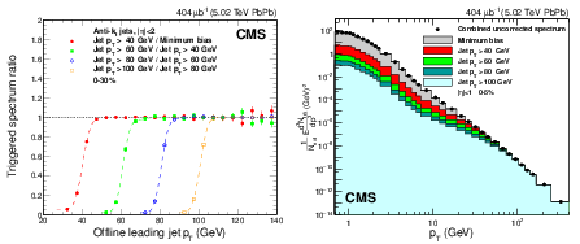
png pdf |
Figure 1:
Left: ratio of the leading jet $ {p_{\mathrm {T}}} $ distributions in PbPb collisions in the 0-30% centrality range from various triggers, after the data have been normalized to one another. Lines have been added to guide the eye. Right: contributions from the various jet triggers (colored histograms) to the combined, but otherwise uncorrected, track spectrum (black markers) in the 0-5% centrality range in PbPb collisions. The statistical uncertainties are smaller than the size of the data markers. |

png pdf |
Figure 1-a:
Ratio of the leading jet $ {p_{\mathrm {T}}} $ distributions in PbPb collisions in the 0-30% centrality range from various triggers, after the data have been normalized to one another. Lines have been added to guide the eye. |

png pdf |
Figure 1-b:
Contributions from the various jet triggers (colored histograms) to the combined, but otherwise uncorrected, track spectrum (black markers) in the 0-5% centrality range in PbPb collisions. The statistical uncertainties are smaller than the size of the data markers. |
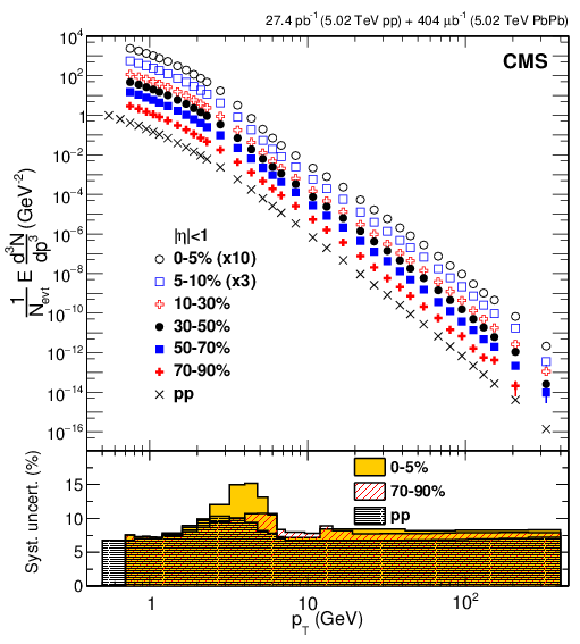
png pdf |
Figure 2:
(Top panel) Charged-particle per-event yields measured in various PbPb centrality classes, as well as in pp data. A factor of 70 mb is used to scale the pp spectrum from a differential cross section to a per-event yield for direct comparison. The statistical uncertainties are smaller than the size of the markers for most points. (Bottom panel) Systematic uncertainties as a function of $ {p_{\mathrm {T}}} $ for representative data sets. The pp uncertainty contains a 2.3% fully correlated uncertainty in the pp integrated luminosity. |
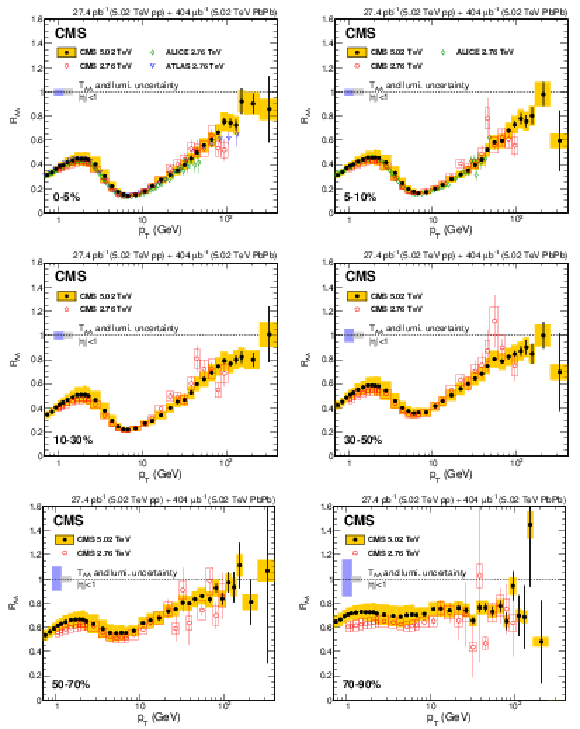
png pdf |
Figure 3:
Charged-particle $ R_{\mathrm {AA}} $ measured in six different centrality ranges at $ \sqrt { s_{\mathrm {NN}} } = $ 5.02 TeV compared to results at $ \sqrt { s_{\mathrm {NN}} } = $ 2.76 TeV from CMS [11] (all centrality bins), ALICE [9] (in the 0-5% and 5-10% centrality ranges), and ATLAS [10] (in the 0-5% centrality range). The yellow boxes represents the systematic uncertainty of the 5.02 TeV CMS points. |
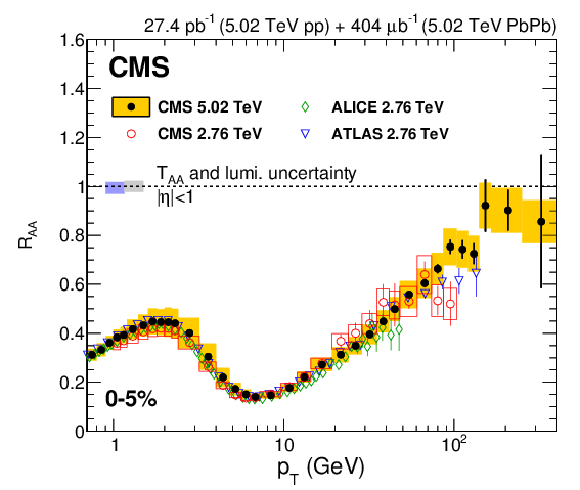
png pdf |
Figure 3-a:
Charged-particle $ R_{\mathrm {AA}} $ measured in the 0-5% centrality range at $ \sqrt { s_{\mathrm {NN}} } = $ 5.02 TeV compared to results at $ \sqrt { s_{\mathrm {NN}} } = $ 2.76 TeV from CMS [11], ALICE [9], and ATLAS [10]. The yellow boxes represents the systematic uncertainty of the 5.02 TeV CMS points. |
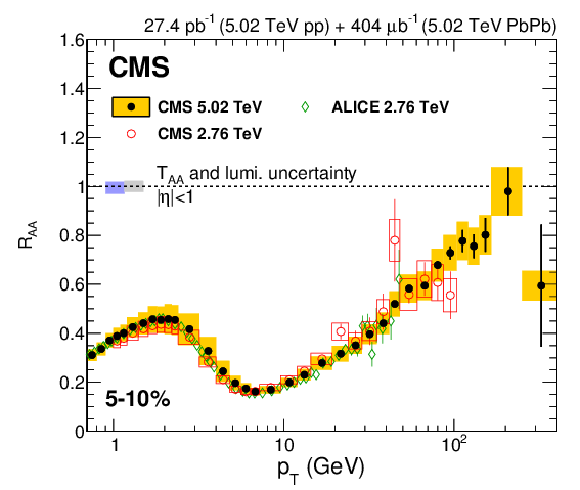
png pdf |
Figure 3-b:
Charged-particle $ R_{\mathrm {AA}} $ measured in the 5-10% centrality range at $ \sqrt { s_{\mathrm {NN}} } = $ 5.02 TeV compared to results at $ \sqrt { s_{\mathrm {NN}} } = $ 2.76 TeV from CMS [11], and ALICE [9]. The yellow boxes represents the systematic uncertainty of the 5.02 TeV CMS points. |
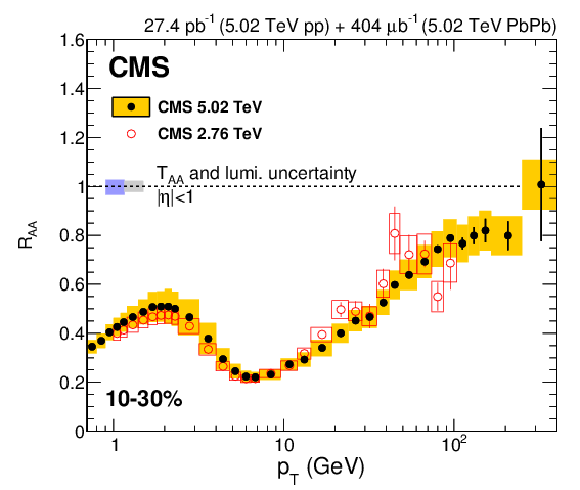
png pdf |
Figure 3-c:
Charged-particle $ R_{\mathrm {AA}} $ measured in the 10-30% centrality range at $ \sqrt { s_{\mathrm {NN}} } = $ 5.02 TeV compared to results at $ \sqrt { s_{\mathrm {NN}} } = $ 2.76 TeV from CMS [11]. The yellow boxes represents the systematic uncertainty of the 5.02 TeV CMS points. |
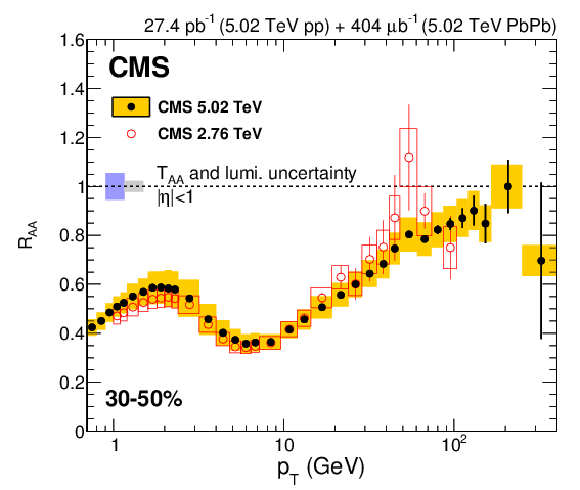
png pdf |
Figure 3-d:
Charged-particle $ R_{\mathrm {AA}} $ measured in the 30-50% centrality range at $ \sqrt { s_{\mathrm {NN}} } = $ 5.02 TeV compared to results at $ \sqrt { s_{\mathrm {NN}} } = $ 2.76 TeV from CMS [11]. The yellow boxes represents the systematic uncertainty of the 5.02 TeV CMS points. |
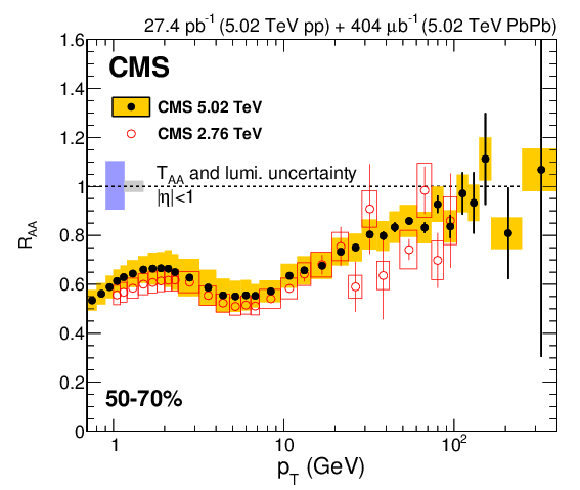
png pdf |
Figure 3-e:
Charged-particle $ R_{\mathrm {AA}} $ measured in the 50-70% centrality range at $ \sqrt { s_{\mathrm {NN}} } = $ 5.02 TeV compared to results at $ \sqrt { s_{\mathrm {NN}} } = $ 2.76 TeV from CMS [11]. The yellow boxes represents the systematic uncertainty of the 5.02 TeV CMS points. |

png pdf |
Figure 3-f:
Charged-particle $ R_{\mathrm {AA}} $ measured in the 70-90% centrality range at $ \sqrt { s_{\mathrm {NN}} } = $ 5.02 TeV compared to results at $ \sqrt { s_{\mathrm {NN}} } = $ 2.76 TeV from CMS [11]. The yellow boxes represents the systematic uncertainty of the 5.02 TeV CMS points. |
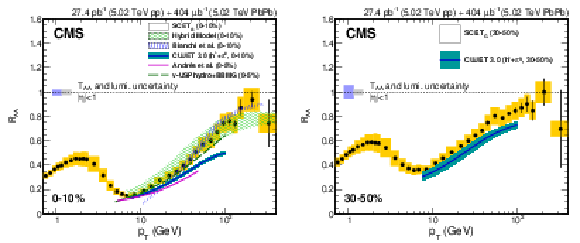
png pdf |
Figure 4:
Charged-particle $ R_{\mathrm {AA}} $ measured in the 0-10% (left) and 30-50% (right) centrality ranges at $ \sqrt { s_{\mathrm {NN}} } = $ 5.02 TeV compared to predictions of models from Refs. [36,37,38,39]. The yellow band represents the systematic uncertainty of the 5.02 TeV CMS points. |

png pdf |
Figure 4-a:
Charged-particle $ R_{\mathrm {AA}} $ measured in the 0-10% centrality range at $ \sqrt { s_{\mathrm {NN}} } = $ 5.02 TeV compared to predictions of models from Refs. [36,37,38,39]. The yellow band represents the systematic uncertainty of the 5.02 TeV CMS points. |
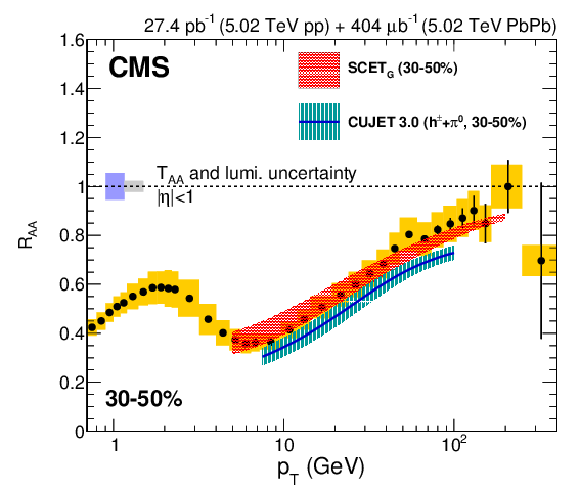
png pdf |
Figure 4-b:
Charged-particle $ R_{\mathrm {AA}} $ measured in the 30-50% centrality range at $ \sqrt { s_{\mathrm {NN}} } = $ 5.02 TeV compared to predictions of models from Refs. [36,37,38,39]. The yellow band represents the systematic uncertainty of the 5.02 TeV CMS points. |
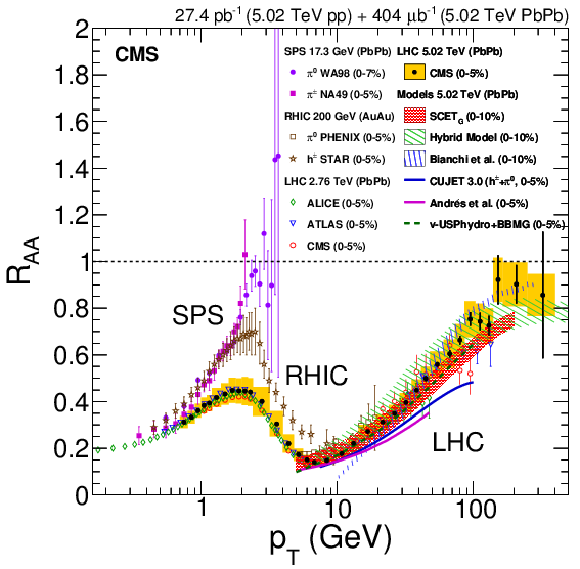
png pdf |
Figure 5:
Measurements of the nuclear modification factors in central heavy-ion collisions at four different center-of-mass energies, for neutral pions (SPS, RHIC), charged hadrons ($h^{\pm }$) (SPS, RHIC), and charged particles (LHC), from Refs. [3,4,9,10,11,44,45,46], compared to predictions of four models for $ \sqrt { s_{\mathrm {NN}} } = $ 5.02 TeV PbPb collisions from Refs. [36,37,38,39]. The error bars represent the statistical uncertainties. The yellow band around the 5.02 TeV CMS data points show the systematic uncertainties of this measurement, including that of the integrated luminosity. The $T_\mathrm {AA}$ uncertainties, of the order of $\pm $5%, are not shown. Percentage values in parentheses indicate centrality ranges. |

png pdf |
Figure 6:
Measurements of the nuclear modification factor for an inclusive centrality class for both PbPb and pPb collisions. The $ {R_{\mathrm{ p } \mathrm {A}}} $ values are formed using the previously published CMS pPb data [13] and the pp reference spectrum described in this paper. Please refer to the main text about the exact procedure followed. The green and orange boxes show the systematic uncertainties for $ {R_{\mathrm{ p } \mathrm {A}}} $ and $ R_{\mathrm {AA}} $, respectively, while the $T_{\mathrm{ p } \mathrm {A}}$, $T_\mathrm {AA}$, and pp luminosity uncertainties are shown as boxes at low $ {p_{\mathrm {T}}} $ around unity. |
| Tables | |
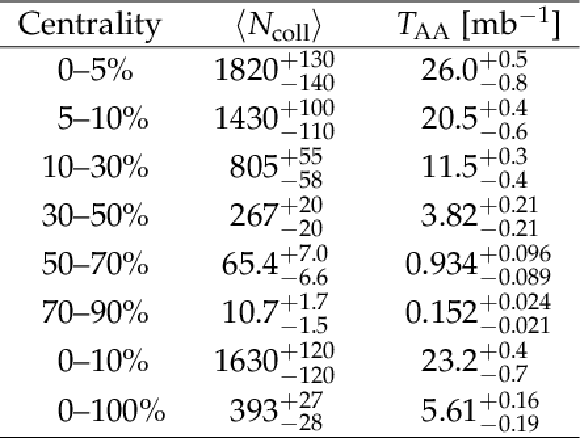
png pdf |
Table 1:
The values of $< N_\text {coll} > $ and $T_\mathrm {AA}$ and their uncertainties in $ \sqrt { s_{\mathrm {NN}} } = $ 5.02 TeV PbPb collisions for the centrality ranges used in this paper. |

png pdf |
Table 2:
Summary of the $ {E_{\mathrm {T}}} $ and $ {p_{\mathrm {T}}} $ thresholds of the various L1 and HLT triggers used in the analysis for the two colliding systems. Please refer to the text about the exact meaning of the thresholds. Only the highest-threshold triggers collected data unprescaled. The MB symbol refers to seeding by a minimum-bias trigger. |
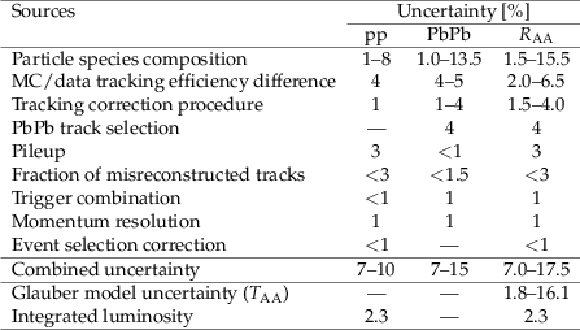
png pdf |
Table 3:
Systematic uncertainties associated with the measurement of the charged-particle spectra and $ R_{\mathrm {AA}} $ using $ \sqrt { s_{\mathrm {NN}} } = $ 5.02 TeV pp and PbPb collision data. The ranges quoted cover both the $ {p_{\mathrm {T}}} $ and the centrality dependence of the uncertainties. The combined uncertainty in $ R_{\mathrm {AA}} $ does not include the integrated luminosity and the $T_\mathrm {AA}$ uncertainties. |
| Summary |
| The transverse momentum spectra of charged particles in pp and PbPb collisions at $\sqrt{s_{\mathrm{NN}}}= $ 5.02 TeV have been measured in the pseudorapidity window $ | \eta | < $ 1 in the $ p_{\mathrm{T}} $ ranges of 0.5-400 (pp) and 0.7-400 GeV (PbPb). Using these spectra, the nuclear modification factor ${R_\mathrm{AA}} $ has been constructed in several bins of collision centrality. In the 0-5% bin, the ${R_\mathrm{AA}} $ shows a maximum suppression of a factor of 7-8 around $ p_{\mathrm{T}}= $ 7 GeV. At higher $p_{\mathrm{T}}$, it exhibits a rise, reaching a value of ${R_\mathrm{AA}} = $ 0.86 $\pm$ 0.28 in the $ p_{\mathrm{T}}$ bin from 250 to 400 GeV. As collisions become more peripheral, a weakening of both the magnitude and $p_{\mathrm{T}}$ dependence of this suppression is observed. Comparisons of the measured ${R_\mathrm{AA}} $ values to the 2.76 TeV results reveal similar $ p_{\mathrm{T}}$ dependence and similar suppression. Predictions of the high-$ p_{\mathrm{T}} $ $ {R_\mathrm{AA}} $ coming from the scet$_G$ and v-usphydro+BBMG models are found to approximately reproduce the present data. The cujet 3.0 model and a model parametrizing the departure of the medium transport coefficient, $\hat{q}$, from an ideal estimate, both predict ${R_\mathrm{AA}} $ suppressions that are slightly larger than seen in data. The nuclear modification factor in pPb collisions has been recomputed switching from an interpolation-based reference to the newly measured pp data at $\sqrt{s}= $ 5.02 TeV. In the pPb system, in contrast to the PbPb system, no suppression is observed in the 2-10 GeV region. A weak momentum dependence is seen for $p_{\mathrm{T}}> $ 10 GeV in the pPb system, leading to a moderate excess above unity at high $ p_{\mathrm{T}} $. The pPb and PbPb nuclear modification factors presented in this paper, covering $ p_{\mathrm{T}}$ ranges up to 120 and 400 GeV, respectively, provide stringent constraints on cold and hot nuclear matter effects. |
| References | ||||
| 1 | J. D. Bjorken | Energy Loss of Energetic Partons in Quark-Gluon Plasma: Possible Extinction of High $ p_{\rm T} $ Jets in Hadron-Hadron Collisions | Technical Report FERMILAB-PUB-82-059-T | |
| 2 | D. d'Enterria | Jet quenching | in Relativistic Heavy Ion Physics, R. Stock, ed., volume 23, 2010 | 0902.2011 |
| 3 | WA98 Collaboration | Transverse mass distributions of neutral pions from $ ^{208} $Pb-induced reactions at 158$ \cdot A $ GeV | EPJC 23 (2002) 225 | nucl-ex/0108006 |
| 4 | D. d'Enterria | Indications of suppressed high $ p_{\rm T} $ hadron production in nucleus - nucleus collisions at CERN-SPS | PLB 596 (2004) 32 | nucl-ex/0403055 |
| 5 | BRAHMS Collaboration | Quark gluon plasma and color glass condensate at RHIC? The perspective from the BRAHMS experiment | Nucl. Phys. A 757 (2005) 1 | nucl-ex/0410020 |
| 6 | PHOBOS Collaboration | The PHOBOS perspective on discoveries at RHIC | Nucl. Phys. A 757 (2005) 28 | nucl-ex/0410022 |
| 7 | STAR Collaboration | Experimental and theoretical challenges in the search for the quark gluon plasma: The STAR collaboration's critical assessment of the evidence from RHIC collisions | Nucl. Phys. A 757 (2005) 102 | nucl-ex/0501009 |
| 8 | PHENIX Collaboration | Formation of dense partonic matter in relativistic nucleus nucleus collisions at RHIC: Experimental evaluation by the PHENIX collaboration | Nucl. Phys. A 757 (2005) 184 | nucl-ex/0410003 |
| 9 | ALICE Collaboration | Centrality dependence of charged particle production at large transverse momentum in Pb--Pb collisions at $ \sqrt{s_{\rm{NN}}} = $ 2.76 TeV | PLB 720 (2013) 52 | 1208.2711 |
| 10 | ATLAS Collaboration | Measurement of charged-particle spectra in Pb+Pb collisions at $ \sqrt{s_{\rm{NN}}} = $ 2.76 TeV with the ATLAS detector at the LHC | JHEP 09 (2015) 050 | 1504.04337 |
| 11 | CMS Collaboration | Study of high-$ p_{\rm T} $ charged particle suppression in PbPb compared to pp collisions at $ \sqrt{s_{\rm{NN}}} = $ 2.76 TeV | EPJC 72 (2012) 1945 | CMS-HIN-10-005 1202.2554 |
| 12 | M. L. Miller, K. Reygers, S. J. Sanders, and P. Steinberg | Glauber modeling in high energy nuclear collisions | Ann. Rev. Nucl. Part. Sci. 57 (2007) 205 | nucl-ex/0701025 |
| 13 | CMS Collaboration | Nuclear effects on the transverse momentum spectra of charged particles in pPb collisions at $ \sqrt{s_{\rm{NN}}} = $ 5.02 TeV | EPJC 75 (2015) 237 | |
| 14 | ATLAS Collaboration | Transverse momentum, rapidity, and centrality dependence of inclusive charged-particle production in $ \sqrt{s_{\rm{NN}}} = $ 5.02 TeV p+Pb collisions measured by the ATLAS experiment | Submitted to PLB | 1605.06436 |
| 15 | ALICE Collaboration | Transverse Momentum Distribution and Nuclear Modification Factor of Charged Particles in p-Pb Collisions at $ \sqrt{s_{\rm{NN}}} = $ 5.02 TeV | PRL 110 (2013) 082302 | 1210.4520 |
| 16 | CMS Collaboration | The CMS experiment at the CERN LHC | JINST 3 (2008) S08004 | CMS-00-001 |
| 17 | B. Alver et al. | Importance of correlations and fluctuations on the initial source eccentricity in high-energy nucleus-nucleus collisions | PRC 77 (2008) 014906 | 0711.3724 |
| 18 | CMS Collaboration | Observation and studies of jet quenching in PbPb collisions at nucleon-nucleon center-of-mass energy = 2.76 TeV | PRC 84 (2011) 024906 | CMS-HIN-10-004 1102.1957 |
| 19 | Particle Data Group Collaboration | Review of Particle Physics | CPC 38 (2014) 090001 | |
| 20 | H. De Vries, C. W. De Jager, and C. De Vries | Nuclear charge-density-distribution parameters from elastic electron scattering | At. Data Nucl. Data Tables 36 (1987) 495 | |
| 21 | M. Cacciari, G. P. Salam, and G. Soyez | The anti-$ k_t $ jet clustering algorithm | JHEP 04 (2008) 063 | 0802.1189 |
| 22 | M. Cacciari, G. P. Salam, and G. Soyez | FastJet user manual | EPJC 72 (2012) 1896 | 1111.6097 |
| 23 | O. Kodolova, I. Vardanian, A. Nikitenko, and A. Oulianov | The performance of the jet identification and reconstruction in heavy ions collisions with CMS detector | EPJC 50 (2007) 117 | |
| 24 | CMS Collaboration | Description and performance of track and primary-vertex reconstruction with the CMS tracker | JINST 9 (2014) P10009 | CMS-TRK-11-001 1405.6569 |
| 25 | CMS Collaboration | Commissioning of the Particle-Flow reconstruction in Minimum-Bias and Jet Events from pp Collisions at 7 TeV | CDS | |
| 26 | T. Sj\"ostrand, S. Mrenna, and P. Z. Skands | A brief introduction to PYTHIA 8.1 | CPC 178 (2008) 852 | 0710.3820 |
| 27 | CMS Collaboration | Event generator tunes obtained from underlying event and multiparton scattering measurements | EPJC 76 (2016) 155 | CMS-GEN-14-001 1512.00815 |
| 28 | I. P. Lokhtin and A. M. Snigirev | A model of jet quenching in ultrarelativistic heavy ion collisions and high-$ p_{\rm T} $ hadron spectra at RHIC | EPJC 45 (2006) 211 | hep-ph/0506189 |
| 29 | CMS Collaboration | Measurement of transverse momentum relative to dijet systems in PbPb and pp collisions at $ \sqrt{s_{\rm{NN}}} = $ 2.76 TeV | JHEP 01 (2016) 006 | CMS-HIN-14-010 1509.09029 |
| 30 | K. Werner, F.-M. Liu, and T. Pierog | Parton ladder splitting and the rapidity dependence of transverse momentum spectra in deuteron-gold collisions at RHIC | PRC 74 (2006) 044902 | hep-ph/0506232 |
| 31 | T. Pierog et al. | EPOS LHC: Test of collective hadronization with data measured at the CERN Large Hadron Collider | PRC 92 (2015) 034906 | 1306.0121 |
| 32 | CMS Collaboration | Measurement of Tracking Efficiency | CDS | |
| 33 | CMS Collaboration | Measurement of the elliptic anisotropy of charged particles produced in PbPb collisions at $ \sqrt{s_{\rm{NN}}} = $ 2.76 TeV | PRC 87 (2013) 014902 | CMS-HIN-10-002 1204.1409 |
| 34 | J. W. Cronin et al. | Production of hadrons at large transverse momentum at 200, 300, and 400 GeV | PRD 11 (1975) 3105 | |
| 35 | PHENIX Collaboration | Spectra and ratios of identified particles in Au+Au and $ d $+Au collisions at $ \sqrt{s_{\rm{NN}}} = $ 200 GeV | PRC 88 (2013) 024906 | 1304.3410 |
| 36 | Y.-T. Chien et al. | Jet quenching from QCD evolution | PRD 93 (2016) 074030 | 1509.02936 |
| 37 | J. Xu, J. Liao, and M. Gyulassy | Bridging soft-hard transport properties of quark-gluon plasmas with CUJET3.0 | JHEP 02 (2016) 169 | 1508.00552 |
| 38 | C. Andr\'es et al. | Energy versus centrality dependence of the jet quenching parameter $ \hat{q} $ at RHIC and LHC: a new puzzle? | EPJC 76 (2016) 475 | 1606.04837 |
| 39 | J. Noronha-Hostler, B. Betz, J. Noronha, and M. Gyulassy | Event-by-Event Hydrodynamics $ + $ Jet Energy Loss: A Solution to the $ R_{\rm AA} \otimes v_{\rm 2} $ Puzzle | PRL 116 (2016) 252301 | 1602.03788 |
| 40 | M. Gyulassy, P. Levai, and I. Vitev | Jet tomography of Au+Au reactions including multigluon fluctuations | PLB 538 (2002) 282 | nucl-th/0112071 |
| 41 | R. Baier | Jet quenching | Nucl. Phys. A 715 (2003) 209 | hep-ph/0209038 |
| 42 | J. Noronha-Hostler et al. | Bulk viscosity effects in event-by-event relativistic hydrodynamics | PRC 88 (2013) 044916 | 1305.1981 |
| 43 | B. Betz, M. Gyulassy, and G. Torrieri | Fourier Harmonics of High-$ p_{\rm T} $ Particles Probing the Fluctuating Intitial Condition Geometries in Heavy-Ion Collisions | PRC 84 (2011) 024913 | 1102.5416 |
| 44 | PHENIX Collaboration | Neutral pion production with respect to centrality and reaction plane in Au$ + $Au collisions at $ \sqrt{s_{\rm{NN}}} = $ 200 GeV | PRC 87 (2013) 034911 | 1208.2254 |
| 45 | STAR Collaboration | Transverse momentum and collision energy dependence of high $ p_{\rm T} $ hadron suppression in Au+Au collisions at ultrarelativistic energies | PRL 91 (2003) 172302 | nucl-ex/0305015 |
| 46 | NA49 Collaboration | High transverse momentum hadron spectra at $ \sqrt{s_{\rm NN}} = $ 17.3 GeV, in Pb+Pb and p+p collisions | PRC 77 (2008) 034906 | 0711.0547 |
| 47 | CMS Collaboration | Evidence for Collective Multiparticle Correlations in pPbCollisions | PRL 115 (2015) 012301 | CMS-HIN-14-006 1502.05382 |
| 48 | M. Arneodo | Nuclear effects in structure functions | Phys. Rep. 240 (1994) 301 | |

|
Compact Muon Solenoid LHC, CERN |

|

|

|

|

|

|